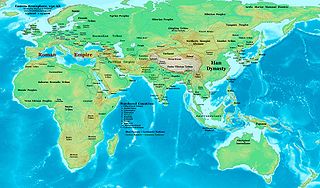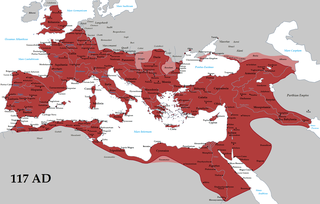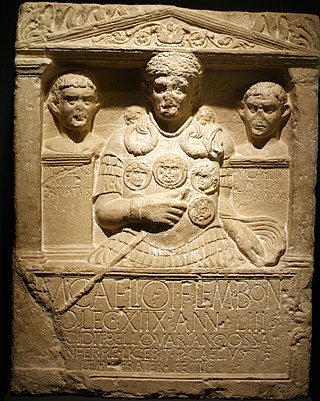
The 1st century was the century spanning AD 1 through AD 100 (C) according to the Julian calendar. It is often written as the 1st century AD or 1st century CE to distinguish it from the 1st century BC which preceded it. The 1st century is considered part of the Classical era, epoch, or historical period. The Roman Empire, Han China and the Parthian Persia were the most powerful and hegemonic states.

The 10s decade ran from January 1, AD 10, to December 31, AD 19.

The 20s decade ran from January 1, AD 20, to December 31, AD 29.

The 30s decade ran from January 1, AD 30, to December 31, AD 39.

The 40s decade ran from January 1, AD 40, to December 31, AD 49.

The 50s decade ran from January 1, 50, to December 31, 59. It was the sixth decade in the Anno Domini/Common Era, if the nine-year period from 1 AD to 9 AD is considered as a "decade".

The 110s was a decade that ran from January 1, AD 110, to December 31, AD 119.
This article concerns the period 39 BC – 30 BC.
AD 4 was a common year starting on Wednesday or a leap year starting on Tuesday of the Julian calendar and a leap year starting on Tuesday of the Proleptic Julian calendar. In the Roman Empire, it was known as the Year of the Consulship of Catus and Saturninus. The denomination "AD 4" for this year has been used since the early medieval period, when the Anno Domini calendar era became the prevalent method in Europe for naming years.
AD 48 (XLVIII) was a leap year starting on Monday of the Julian calendar. At the time, it was known as the Year of the Consulship of Vitellius and Poplicola. The denomination AD 48 for this year has been used since the early medieval period, when the Anno Domini calendar era became the prevalent method in Europe for naming years.
The 0s BC is the period between 9 BC and 1 BC, the last nine years of the before Christ era. It is one of two "0-to-9" decade-like timespans that contain nine years, along with the 0s.
AD 53 (LIII) was a common year starting on Monday of the Julian calendar. At the time, it was known as the Year of the Consulship of Silanus and Antonius. The denomination AD 53 for this year has been used since the early medieval period, when the Anno Domini calendar era became the prevalent method in Europe for naming years.
This article concerns the period 19 BC – 10 BC.
Year 37 BC was either a common year starting on Monday, Tuesday or Wednesday or a leap year starting on Monday or Tuesday of the Julian calendar and a leap year starting on Monday of the Proleptic Julian calendar. At the time, it was known as the Year of the Consulship of Agrippa and Gallus. The denomination 37 BC for this year has been used since the early medieval period, when the Anno Domini calendar era became the prevalent method in Europe for naming years.

Herod Agrippa II, officially named Marcus Julius Agrippa and sometimes shortened to Agrippa, was the last ruler from the Herodian dynasty, reigning over territories outside of Judea as a Roman client. Agrippa II fled Jerusalem in 66, fearing the Jewish uprising, and he supported the Roman side in the First Jewish–Roman War.

Herod Antipas was a 1st-century ruler of Galilee and Perea. He bore the title of tetrarch and is referred to as both "Herod the Tetrarch" and "King Herod" in the New Testament. He was a son of Herod the Great and a grandson of Antipater the Idumaean. He is widely known today for accounts in the New Testament of his role in events that led to the executions of John the Baptist and Jesus of Nazareth. His father, Herod the Great, was described in the account as ordering the Massacre of the Innocents, marking the earliest Biblical account of the concerns of the government in Jerusalem regarding Jesus' existence.

Judaea was a Roman province from 6 to 132 CE, which at its height incorporated the Levantine regions of Judea, Idumea, Samaria, and Galilee, and parts of the costal plain including Philistia, extending over the territories of the Hasmonean and Herodian kingdoms. The name Judaea was derived from the Iron Age Kingdom of Judah, that was centered predominantly in Judea.

The Herodian tetrarchy was a regional division of a client state of Rome, formed following the death of Herod the Great in 4 BCE. The latter's client kingdom was divided between his sister Salome I and his sons Herod Archelaus, Herod Antipas, and Philip. Upon the deposition of Herod Archelaus in 6 CE, his territories were transformed into a Roman province. With the death of Salome I in 10 CE, her domain was also incorporated into a province.

The 0s began on January 1, AD 1 and ended on December 31, AD 9, covering the first nine years of the Common Era. It is one of two "0-to-9" decade-like timespans that contain nine years, along with the 0s BC.

Cypros (1st-century) was a queen consort of Judea. She was married to king Herod Agrippa.












